How to Set up an RSS Feed in 2025: Food for Thought
If you’re delivering any kind of content to the masses, whether that’s podcasts, articles, videos, music or anything in between, chances are you could benefit from setting up an RSS feed to help deliver that content to your audience.
If you have no idea what this means, or if you want to learn in detail how to set up an RSS feed, then you’ve come to the right place.
What Is an RSS Feed?
“RSS” is the abbreviation of “really simple syndication,” and it is a format for automatically delivering content to users without them having to manually check your website or blog for updates.
RSS has been around for a long time, and although it’s not as prevalent as it once was, it’s still one of the primary ways you can ensure that whatever you put online reaches its intended audience.
It’s also pretty much the only way for you to reliably publish podcasts, as all podcast clients will require an RSS structure before they accept you on their platforms.
Once you have an RSS feed set up for your content, your audience will be able to plug this into their own RSS readers, which will then provide them with automatic updates whenever you post anything new. This ensures that your posts won’t fly under the radar and saves your users the hassle of having to manually check your website every day for new content.
How to Create an RSS Feed
If you want to manually set up an RSS feed, it requires some coding. RSS feeds are made up of XML code and split into separate nodes, each carrying one item (for example, a podcast or article) that you want delivered to your subscribers.
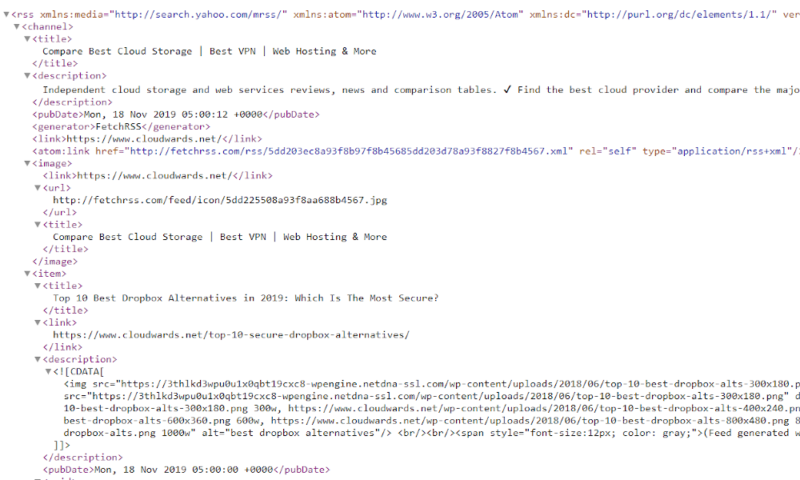
Luckily, there are plenty of generators that do most of the heavy lifting for you when it comes to the code part, so you don’t necessarily need to teach yourself how to code, just to set up your feed.
Although you can choose any of these generators, for this tutorial we’ll focus on the one offered by FetchRSS.com, as it comes with a very easy-to-use visual interface that requires no knowledge of code to use.
You do have to register to use the tool, but the free plan allows you to create five separate feeds, which remain active as long as someone accesses them once every seven days.
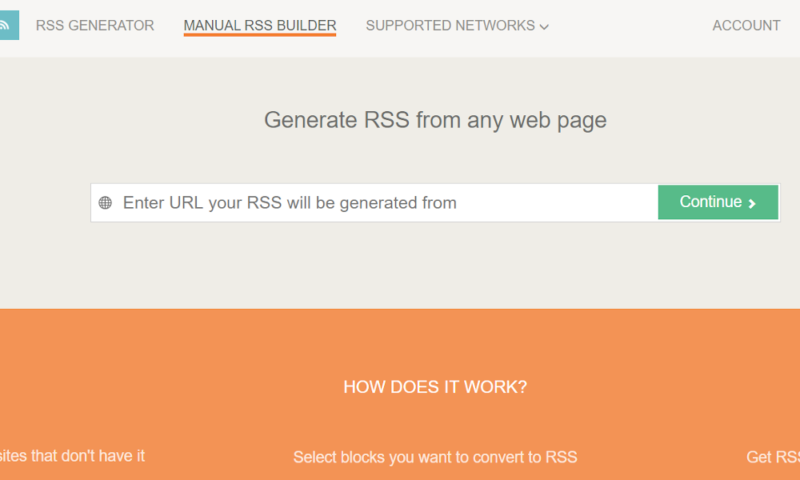
First, head over to FetchRSS.com and click on “manual RSS builder” at the top of the page. This will take you to the generator, where you’ll need to enter the website URL that you wish to create a feed for.
Now you’ll get to see a preview of your website, and your next step will be to pick a “news item.” Basically, this means the elements that you want your feed to distribute.
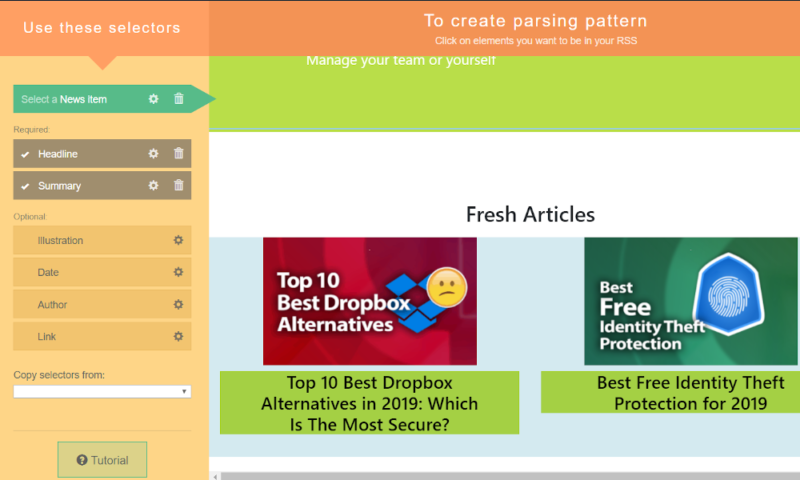
Once you’ve selected the type of website element you want to go in your feed, you need to select the headline (simply click on the headline of your blog post, for example) and summary (for example, the preview text for your article or blog post).
Once this is done, you should be presented with a preview of your feed on the right side of the screen, and if all you want is a basic feed, you can click on “generate RSS” and you’re done.
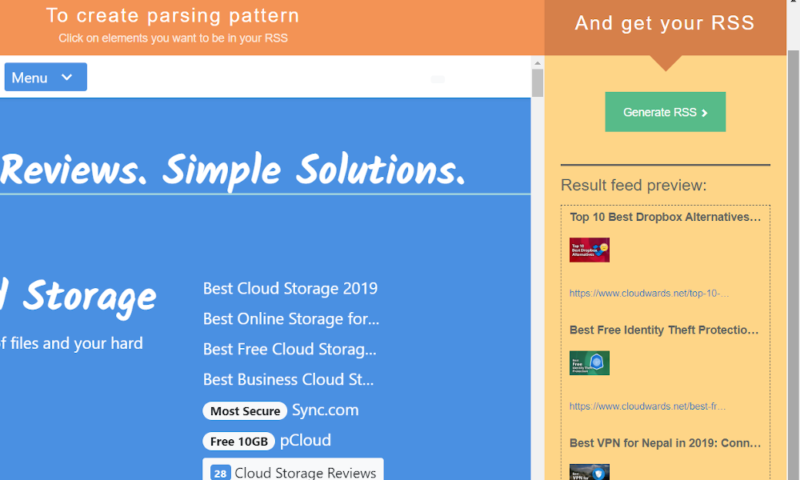
If you want to add some more information to the elements in your feed, you can. The generator allows you to add an illustration, date, author and link to the page itself.
You can add these by going through the list on the left-hand side and then either clicking on them as they appear on your website or defining specific HTML tags (for example, <src> for the illustrations) if you’re familiar with basic website code.
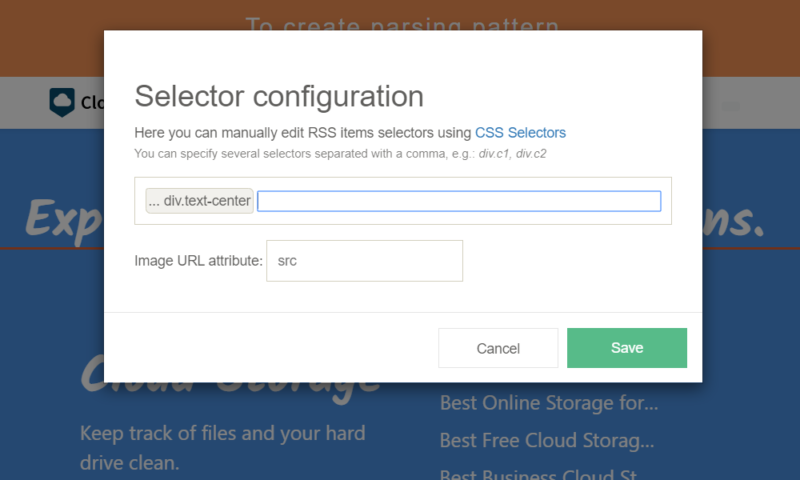
Once you’ve clicked the “generate RSS” button, you’ll be given a hyperlink to an XML page. Simply add this link somewhere on your webpage, and users with an RSS reader installed on their device will be given the option to subscribe to the feed when they click it. If you want to get fancy, add the link to the standard RSS icon to make it clear to your readers what it is.
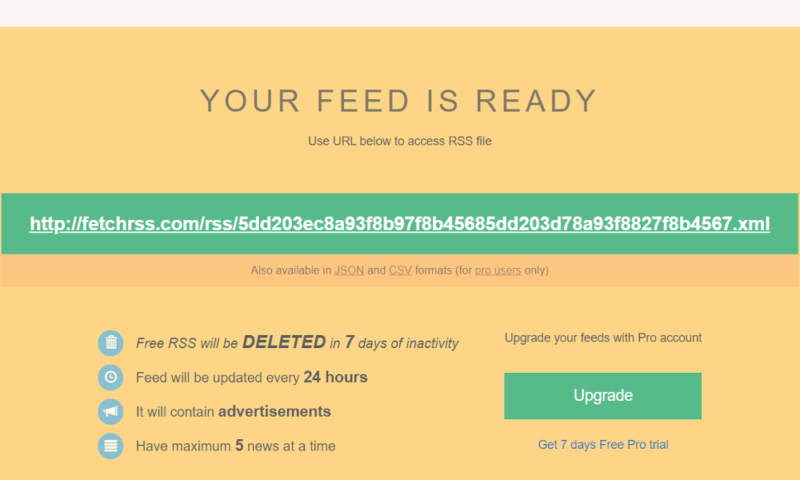
Setting Up an RSS Feed
- Open your web browser and go to FetchRSS.com
- Register for a free account
- Click on “manual RSS builder”
- Enter the URL of your website
- Select the news item you want the feed to distribute
- Select the headline within the news item
- Select a description or summary within the news item
- Add any optional parameters, such as illustrations and author, if those are present on your site
- Click “generate RSS”
- Copy the XML link provided and add it to your website
WordPress RSS Feed
If your website is already hosted by WordPress, then the process of setting up an RSS feed is significantly less cumbersome than if you’re just doing it manually, as it doesn’t require registration with a separate service or coding know-how to accomplish.
How to Add an RSS Feed to Your WordPress Website
WordPress automatically creates several types of feeds from your website, saving you the hassle of doing so yourself. To find the feed, simply take your website URL and add a “/feed/” at the end. For example: “https://exampleurl.com/feed/.”
All you need to do now is to take that URL and put it somewhere on your website, preferably with the RSS feed icon so that your readers know what it is. This is traditionally placed at the bottom of the website, together with any social media links you may have.
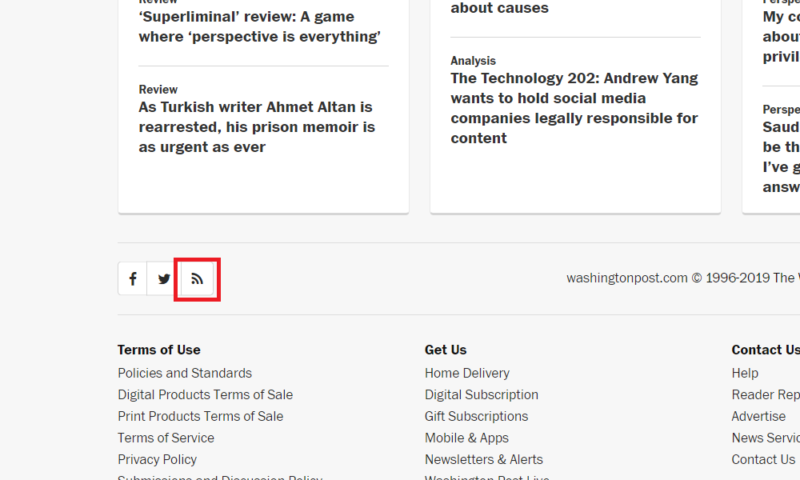
On the other hand, if you want your WordPress website to display the contents of an RSS feed, you can use the built-in RSS widget. Simply go to the customization section, select “widgets,” click “add widget,” choose RSS and enter the URL we talked about earlier. You can also add a title and some rules on what items to display, but these are optional.
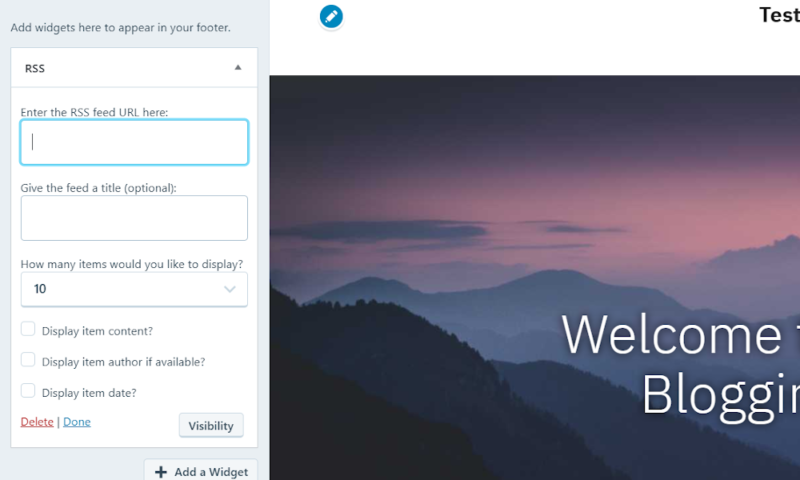
Adding an RSS Feed to Your WordPress Website
- Create your RSS URL by adding “/feed/” at the end
- Add your RSS URL somewhere on your website for your users to click on
If you want to display the contents of a feed directly on your site, follow these steps:
- Enter the admin area of your WordPress site
- Go to “customize” and then “widgets”
- Click “add a widget,” then “RSS”
- Add the feed URL as well as optional parameters, such as title and display rules
Podcast RSS Feed
Creating an RSS feed for podcasts requires a few extra pieces of information. This is because podcast clients demand certain tags in the XML code in order to distribute your podcasts.
Thus, you can’t just take your overall website RSS and send it over to iTunes, as you’ll most likely be missing the required information, and the feed will probably include all sorts of stuff besides podcasts, which will lead the clients to reject your feed.
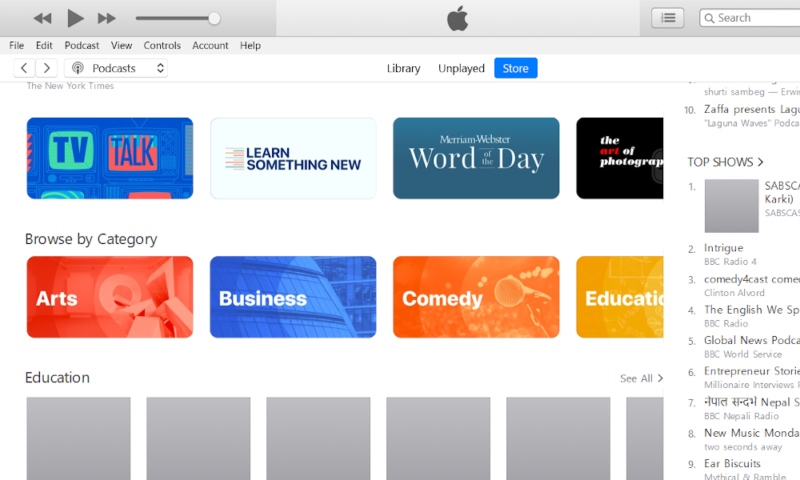
If your website (and podcast) is hosted on a service like WordPress or Squarespace, there are plugins and built-in functionality to let you easily create an iTunes-compliant RSS feed for your podcasts. For example, in WordPress you can install the PowerPress plugin, which lets you post a podcast just like you would any other WordPress post.
You can then click on “submit your podcast to iTunes and other podcast directories” and PowerPress will give you a URL that includes all of the required information, which you can then submit wherever you like.
If you’re not hosting your website and podcast with something like WordPress, you’ll need to manually configure your RSS feed. Apple helpfully provides a sample feed for this purpose, which you can find here.
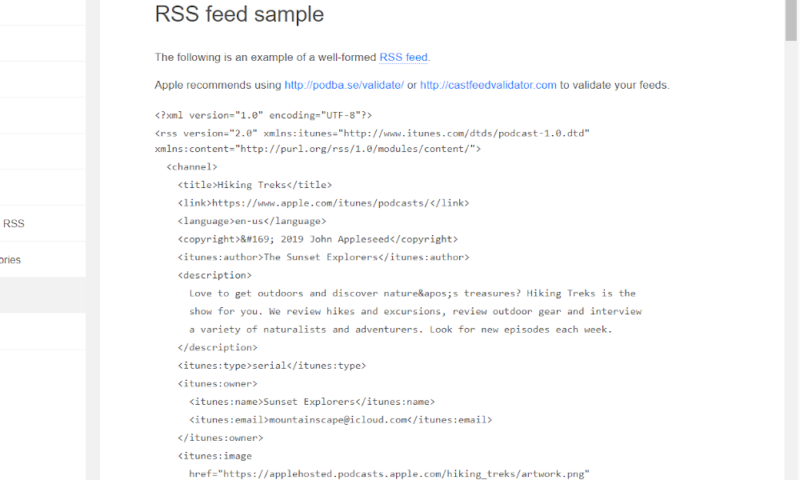
You can copy all of this and simply change the information inside the tags. Most of the tags are pretty self-explanatory, such as the author and owner tags (that’s you), the image tag (the logo that shows in the podcast app), the category that your podcast fits into and whether or not the content contains explicit language.
Once you get to the part of the code labelled “item,” this is where your individual episodes will be located. Each “item” needs to contain an episode title, description, publishing date, the length and type of the audio file, as well as a direct link to it.
You’ll then have to save all this in an XML file and host it on your website. The link to this file is what you’ll want to submit to iTunes, Overcast or Spotify. Whenever you release a new episode, you’ll have to update the file and add a new “item” for the new episode.
How to Set up a Podcast RSS Feed
- Add the PowerPress plugin to your WordPress site
- Publish your podcast as a post through the PowerPress plugin
- Click on “submit your podcast to iTunes and other podcast directories”
- Copy the URL provided to you and submit it to the podcast clients of your choice
On the other hand, if you’re doing all this manually, then you’ll want to follow these steps:
- Copy the example podcast feed provided by Apple
- Fill in your podcast information, such as title, author, etc.
- Add “items” for each episode containing a link to the audio file and fill in information, such as the episode title, description and publishing date, in the relevant fields
- Host the XML file you’ve created somewhere on the website
- Submit the XML file’s URL to various podcast clients
Final Thoughts
By following these instructions, you should be able to set up a dedicated RSS feed for whatever type of content you distribute. Although the RSS format certainly isn’t as popular or widespread as it once was, it remains an incredibly useful way to ensure that your audience doesn’t miss out on any of your content, thus greatly increasing your traffic and views.
For podcasts, especially, an RSS feed is absolutely crucial, as this is generally how you distribute your recordings to the various podcast services, such as Apple’s iTunes, Overcast or Spotify.
What did you think of our guide on how to set up an RSS feed? Did we miss an important step or your favorite RSS generator? Let us know in the comments below. Thank you for reading.
